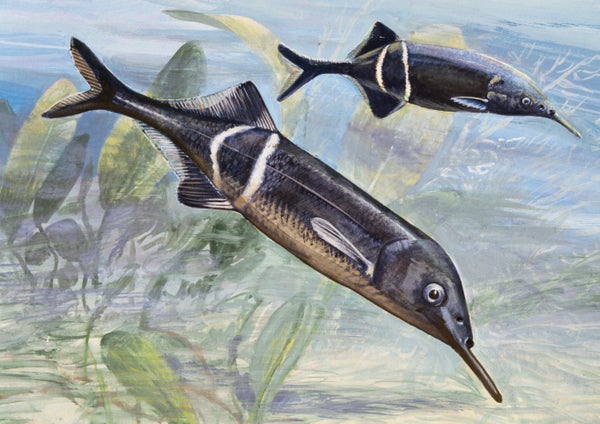With a trunk-like snout, an enormous brain and shimmying moves, freshwater elephantnose fish seem straight out of a science-fiction novel. But these oddballs’ most shocking trait is their ability to emit and sense electricity. They use electric currents to pinpoint prey and potential mates in the muddy river bottoms where they reside.
Now scientists have discovered that the fish can supercharge this power by working together. In a paper published on Wednesday in the journal Nature, a team of researchers discovered that elephantnose fish are able to pick up on the electric signals of their pulsating peers to collectively sense the world around them. This may expand the fish’s perceptual capabilities, helping them sense prey items and potential foes from farther away.
“We were excited to see that the electrical pulses [of other fish] are not just some background noise,” says Nathaniel Sawtell, a neuroscientist at Columbia University and a co-author of the new paper. “The fish are actually using the pulses of the other fish to their benefit.”
On supporting science journalism
If you're enjoying this article, consider supporting our award-winning journalism by subscribing. By purchasing a subscription you are helping to ensure the future of impactful stories about the discoveries and ideas shaping our world today.
Sawtell has studied the neural wiring of Peters’s elephantnose fish (Gnathonemus petersii) for several years. These fish, which are found in freshwater rivers and lakes throughout central and western Africa and sport a trunklike extension of their mouth, are brainiacs. They possess the highest brain-to-body weight ratio of any vertebrate, including humans.
All this brain power helps harness the fish’s electrical capabilities. While they cannot match the high-voltage outputs of electric eels and stingrays, elephantnose fish can create pulses of charge from an electric organ in their tail. They emit these pulses into the environment in a manner similar to how bats and dolphins utilize sound waves. As the signals bounce off of nearby objects, tiny electroreceptors in the fish’s skin pick up distortions in the electric field.
Researchers have long studied how elephantnose fish perceive their own electric currents. But much less work has been done to determine how these fish make sense of pulses from other fish, especially when they gather in social groups.
To learn more about how elephantnose fish are affected by one another’s electric signals, Sawtell teamed up with his postdoctoral research associate Federico Pedraja to create a computer simulation. Their goal was to model how the electrical environment changed when multiple elephantnose fish were close to one another.
The researchers found that the simulated elephantnose fish were able to essentially tune in to the electric pulses of their neighbors. As one fish created an electric “image” of a nearby object, the other fish in the simulation were able to instantaneously pick up the visual of what the first animal was sensing. If a group of three elephantnose fish approached the same object, the fish would receive slightly different electric images of that object at essentially the same time, allowing them to “see” their surroundings in more detail.
The fish’s ability to transfer these senses without being bogged down by interfering electric signals is surprising, says Sarah Skeels, a zoologist at Queen Mary University of London, who studied the electrical perception of elephantnose fish for her Ph.D. “You would think that other fish might cause an interference, but as they’ve shown, it seems that it can actually enhance some aspects of an object that are ambiguous to individual fish,” says Skeels, who was not involved in the new study.
Teamwork also extended the range of the fish’s perception up to three times further. “By using the pulses of other fish, an individual could see the electrical properties of objects much further away,” Sawtell says. “Electrical fields fall off steeply with distance, so having that electrical field be emitted by another nearby animal can greatly extend the range of its sensing.” Humans have employed a similar strategy to hone radar, which more accurately senses far-off objects when electromagnetic pulses are moving between multiple emitters and receivers.
The researchers bolstered their modeling results with recordings of the elephantnose fish’s neural activity. They found that the region of the animals’ oversize brain that controls the electrosensory system is able to tune in to both an elephantnose fish’s own signals and external electric currents, including the pulses of other fish. The team also observed how elephantnose fish acted when they were placed together in tanks. The researchers observed the fish lining up in straight or perpendicular formations. According to the computer model, these positions appeared to help maximize collective sensing capabilities.
While this is the first known example of collective sensing in electric fish, it may not be the last, Skeels says. She notes that there are hundreds of other species of electric fish, including several highly social species. For example, researchers recently discovered that electric eels can hunt in packs and synchronize their shocks to stun prey. She thinks that it is plausible that some sort of collective sensing may be “a fundamental element of electric fishes’ sensory perception of the world.”
According to Sawtell and Pedraja, the collective sensing of elephantnose fish may help scientists develop artificial sensing technologies in things such as underwater vehicles. But first the researchers need to get a more detailed glimpse at what’s going on inside the noggins of these bizarre fish.
“We don't yet know how the brains of these fish actually process these complex streams of information,” Sawtell says. “We’d like to understand how evolution has fine-tuned the brains of these fish over many millions of years to solve this problem.”
